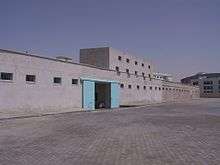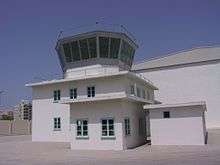Al Mahatta Fort
Al Mahatta Fort ("the station" in Arabic) is located in central Sharjah in the United Arab Emirates. The fort was built by the Ruler of Sharjah in 1932 to afford protection for passengers and staff of Imperial Airways. It was the first British establishment on the Trucial Coast, after an agreement was struck between the British and the ruler of Sharjah in June 1932. It was also used by the Royal Air Force in World War II.


The fort today houses an aviation museum, known as the Al Mahatta Museum.
History
The Imperial Airways route was originally established on the Northern Shore of the Persian Gulf but the agreement to use the route made with the Persian Government lapsed in 1932 and a Southern route was sought. Negotiations with several Trucial Sheikhs resulted in British offers being rejected before, finally, Sharjah's Ruler agreed - with reservations - to host the airfield. An agreement was made on 22 June 1932 with the Ruler, Sultan bin Saqr Al Qasimi, which secured him a monthly rental of 800 Rupees for landing rights and fees and a personal subsidy of 500 Rupees.[1] Concerned that the airfield would result in British interference in Sharjah's internal affairs, he also gained assurances that British shipping would route through Sharjah, providing income for the town's traders.[2]
Sharjah was an overnight stop between Baghdad and Jodphur on the Imperial Airways Eastern Route from Croydon to Brisbane, Australia. It was the first British establishment on the Trucial Coast.[3]
The Sultan agreed to build a rest-house for crew and passengers which was fortified against "possible but unlikely raids by bedouin" according to the 1937 documentary film Air Outpost, which featured Sharjah's airport.[4][5] The ruler also supplied a number of armed men as guards
The route was originally flown by Handley Page HP42s, with two weekly flights landing in Sharjah on Sunday and Wednesday evenings on the outbound flight and Wednesday and Saturday evenings on the return flight.
A backup landing strip was established in Kalba in August 1936, resulting in Kalba's ruler, Said Bin Hamad Al Qasimi being recognised by the British as a Trucial Ruler.
By 1938, Sharjah was no longer an overnight stop on the route although the Imperial Airways flying boat service from Sydney to London included an overnight stop in Dubai, following the establishment of Civil Air Agreements with Dubai's ruler.[3] The outbreak of skirmishing between Dubai and Sharjah in 1940 threatened the security of Sharjah's airport and led to unusual intervention by the British political agent in a land-based dispute: the British had previously restricted their interests and treaties purely to maritime affairs.[3]
The airport was used extensively during World War Two by the RAF, and a new agreement was made with the Ruler of Sharjah establishing an RAF base, which remained in use through to British withdrawal from the UAE in 1971.[6]
No longer in use by Imperial Airways (or its successor BOAC), in 1951, it became the home of the Trucial Oman Scouts.[6]
The airstrip remained in constant use until the development of the current Sharjah International Airport in 1977. The fort building became the Seaface Hotel, then from 1973 was used as a police station, before falling into disrepair. It was restored in the late 1990s to open as a museum in 2000.
1937 Film: Air Outpost
Produced in 1937 by documentary maker Paul Rotha for Strand Films, Air Outpost set out to tell the story of "24 hours at the airport and city of Sharjah, on the Persian Gulf". The film, featuring a score by British composer William Alywn, forms a rare and important historical document of Sharjah and the airport and fort at Mahatta which were at the time, according to the film, "A mile away from the Arab city of Sharjah" and which are now in its centre.
Although dated 1937, the film itself was actually shot in November 1936, Rotha having picked Sharjah for his film as he had traveled the Imperial Airways route a month after its inauguration and before the Mahatta Fort had been built, consequently sleeping in tents.[7]
Al Mahatta Museum
On 14 March 2000, the Al Mahatta Museum was opened, to celebrate the history of flight in the UAE and the region. It also contains the first cinema in the Gulf region, inaugurated in 1945.[8]
References
- Heard-Bey, Frauke (1996). From Trucial States to United Arab Emirates. UK: Longman. p. 298. ISBN 978-0582277281.
- 1976-, Alhammadi, Muna M. Britain and the administration of the Trucial States 1947-1965. Markaz al-Imārāt lil-Dirāsāt wa-al-Buḥūth al-Istirātījīyah. Abu Dhabi. p. 20. ISBN 9789948146384. OCLC 884280680.CS1 maint: numeric names: authors list (link)
- Donald., Hawley (1970). The Trucial States. London: Allen & Unwin. ISBN 978-0049530058. OCLC 152680. p 171
- "IMDB". Retrieved 11 January 2017.
- Air Outpost on Vimeo.
- "The National".
- Stanley-Price, Nicholas (8 February 2012). "Paul Rotha and the Making of Strand Films' Air Outpost (1937)". Historical Journal of Film, Radio and Television. 32: 95–111. doi:10.1080/01439685.2012.648055.
- "Al Mahatta Museum". Sharjah Museums Authority. Retrieved 12 October 2019.